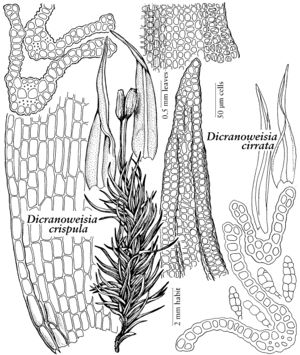Difference between revisions of "Dicranoweisia crispula"
Bryol. Siles., 49. 1869,.
FNA>Volume Importer |
imported>Volume Importer |
||
| (One intermediate revision by the same user not shown) | |||
| Line 71: | Line 71: | ||
|publication year= | |publication year= | ||
|special status= | |special status= | ||
| − | |source xml=https:// | + | |source xml=https://bitbucket.org/aafc-mbb/fna-data-curation/src/2e0870ddd59836b60bcf96646a41e87ea5a5943a/coarse_grained_fna_xml/V27/V27_565.xml |
|genus=Dicranoweisia | |genus=Dicranoweisia | ||
|species=Dicranoweisia crispula | |species=Dicranoweisia crispula | ||
Latest revision as of 21:27, 5 November 2020
Leaves crisped and curled when dry, plane in many leaves, 2-stratose in distal 1/2, cells with longitudinal striolae in distal 1/2 of leaf; usually a few alar cells enlarged on margins, often colored. Specialized asexual reproduction absent. Capsule without differentiated annulus; peristome vertically striolate basally, weakly papillose distally.
Phenology: Capsules mature spring–early summer.
Habitat: Forming cushions on siliceous rock or gravel, occasionally epiphytic or epixylic
Elevation: 10-2000 m
Distribution
Greenland, Alta., B.C., Man., N.B., Nfld. and Labr. (Nfld.), N.S., Nunavut, Ont., Que., Yukon, Alaska, Ariz., Calif., Colo., Idaho, Maine, Mich., Mont., Nev., N.H., N.Mex., N.C., Oreg., S.Dak., Tenn., Utah, Wash., Wyo., Asia.
Discussion
Dicranoweisia crispula is an extremely variable species. In stature the plants vary 1–6 cm, while the leaf length varies 1–3.5 mm. The capsules vary considerably from cylindric to short-elliptic, with the length ranging 0.5–2 mm. The shape and sheathing of the perichaetial leaves is also variable. Although this species is autoicous, sex organs are often absent, especially in terrestrial plants, with sporophytes correspondingly infrequent. Differentiation of alar cells is often weak in North American material and the striolation can also be weak, and is best observed on cells adjacent to the costa. This species is widespread mainly at higher elevations in western North America, but sporadic in the eastern part of the continent, again occurring mainly at higher elevations.
Selected References
None.
